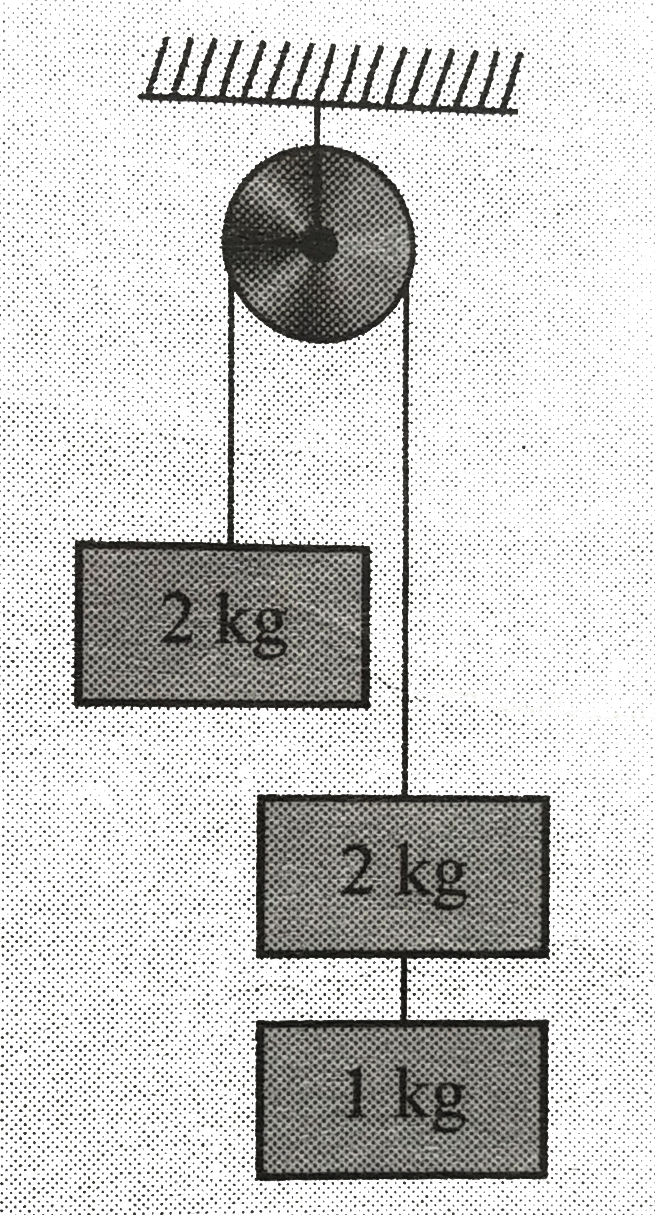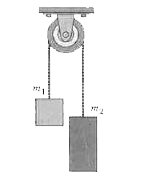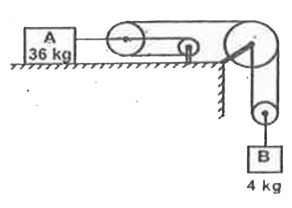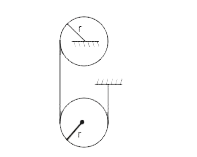In Fig. 5-31, three ballot boxes are connected by cords, one of which wraps over a pulley having negligible friction on its axle and negligible mass. The three masses are mA=30.0 kg, mB=40.0 kg, and mc=10.0 kg.
(a) When the assembly is released from rest, what is the tension in the cord connecting B and C?
(b) When the assembly is released from rest, how far does A move in the first 0.250 s (assuming it does not reach the pulley)?

We use Newton.s second law of motion to find the tension.
Calculation: The net force on the system (of total mass M = 80.0 kg) is the force of gravity acting on the total overhanging mass (mBC=50.0 kg). The magnitude of the acceleration is therefore a=(mBC g)/M=6.125 m/s2. Next we apply Newton.s second law to block C itself (choosing down as the +y direction) and obtain
mCg−TBC=mCα.
This leads to TBC=36.8 N.
(b) When the assembly is released from rest, how far does A move in the first 0.250 s (assuming it does not reach the pulley) ?
Calculation: We use equation of motion (choosing right ward as the +x direction):
Δx=0+12at2=0.191 m.
Topper's Solved these Questions
- FORCE AND MOTION - I BOOK - RESNICK AND HALLIDAYCHAPTER - FORCE AND MOTION - I EXERCISE - CHECKPOINT
5 Videos
- FORCE AND MOTION - I BOOK - RESNICK AND HALLIDAYCHAPTER - FORCE AND MOTION - I EXERCISE - PROBLEMS
52 Videos
- FLUIDSBOOK - RESNICK AND HALLIDAYCHAPTER - FLUIDSEXERCISE - PRACTICE QUESTIONS (Integer Type )
5 Videos
- FORCE AND MOTION-IIBOOK - RESNICK AND HALLIDAYCHAPTER - FORCE AND MOTION-IIEXERCISE - PRACTICE QUESTIONS (Integer Type)
1 Videos
Similar Questions
Consider the system shown in fig. the system os released from rest, find the tension in the cord connected between 1kg and 2 kg blocks.

View SolutionFigure 5-34 shows three blocks attached by cords that loop over frictionless pulleys. Block B lies on a friction-less table, the masses are mA=6.00 kg, mB=8.00 kg, and mC=10.0 kg. When the blocks are released, what is the tension in the cord at the right?

Figure 5-34 Three blocks attached over two pulleys by a cord.
View Solution
Knowledge Check
Two masses are connected by a weightless cord passing over a fictionless pulley (see fig). The tension in the cord connecting the masses will be (g=10m/s−2)
 A20 NB15 NC37.5 ND40 N
A20 NB15 NC37.5 ND40 NBlock B has mass m and is released from rest when it is on top of wedge A, which has a mass 3m. Determine the tension in cord CD needed to hold the wedge from moving while B is sliding down A. Neglect friction.
 A2mgcosθBmg2cosθCmg2sinθDmgsin2θ
A2mgcosθBmg2cosθCmg2sinθDmgsin2θ
Figure 5-50 shows two blocks connected by a cord (of negligible mass) that passes over a frictionless pulley (also of negligible mass). The arrangement is known as Atwood's machine. One block has mass m1=1.30 kg, the other has mass m2=2.80 kg. What are (a) the magnitude of the blocks' acceleration and (b) the tension in the cord ?

View SolutionIf the system is released from rest, determine the speeds of both masses after B has moved 1 m. Neglect friction, the masses of pulleys and inextensible string.

View SolutionTwo uniform cylinders, each of mass m=10 kg and radius r = 150 mm, are connected by a rough belt as shown. If the system is released from rest, determine
the tension in the portion of the belt connecting the two cylinders.

View SolutionThe masses of A,B and C in the figure (Fig. 5.24) are mA=4 kg, mB=2 kg and mC=3 kg. The mass of the movable pulley is 1 kg. Show that the acceleration of A is 9g49
View SolutionIn the previous problem, suppose m2=2.0kgandm3=3.0kg. What should be the mass m so that it remains at rest?
View SolutionIn the arrangement shown in figure pulleys are mass of block A,b and C is m1=5kgm2=4kg and m3=2.5kg respectively .Co-efficient acceleration of friction for both the plane is μ=0.50 Calculate acceleration of which block when system is released from rest

View Solution
